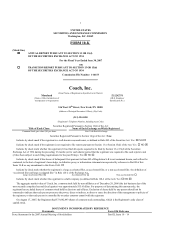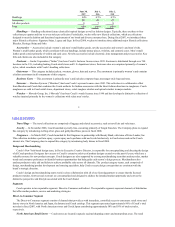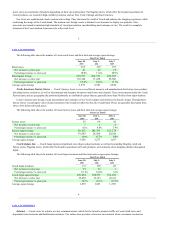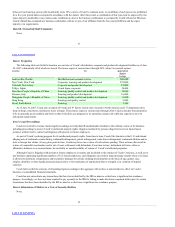Coach 2006 Annual Report Download - page 9
Download and view the complete annual report
Please find page 9 of the 2006 Coach annual report below. You can navigate through the pages in the report by either clicking on the pages listed below, or by using the keyword search tool below to find specific information within the annual report.
As of June 30, 2007, Coach employed approximately 10,100 people, including both full and part time employees. Of these employees,
approximately 3,100 and 4,900 were full time and part time employees, respectively, in the retail field in North America and Japan.
Approximately 50 of Coach’s employees are covered by collective bargaining agreements. Coach believes that its relations with its employees
are good, and it has never encountered a strike or work stoppage.
Geographic information is presented in Note 13 to the Consolidated Financial Statements.
Our Annual Reports on Form 10-K, Quarterly Reports on Form 10-Q, current reports on Form 8-K, and all amendments to these reports
filed or furnished pursuant to Section 13(a) or 15(d) of the Securities Exchange Act of 1934, are available free of charge on our website,
located at www.coach.com, as soon as reasonably practicable after they are filed with or furnished to the Securities and Exchange
Commission. These reports are also available on the Securities and Exchange Commission’s website at www.sec.gov. No information
contained on any of our websites is intended to be included as part of, or incorporated by reference into, this Annual Report on Form 10-K.
The Company has included the Chief Executive Officer (“CEO”) and Chief Financial Officer certifications regarding its public
disclosure required by Section 302 of the Sarbanes-Oxley Act of 2002 as Exhibit 31.1 to this report on Form 10-K. Additionally, the
Company filed with the New York Stock Exchange (“NYSE”) the CEO’s certification regarding the Company’s compliance with the
NYSE’s Corporate Governance Listing Standards (“Listing Standards”) pursuant to Section 303A.12(a) of the Listing Standards, which
indicated that the CEO was not aware of any violations of the Listing Standards by the Company.
You should consider carefully all of the information set forth or incorporated by reference in this document and, in particular, the
following risk factors associated with the Business of Coach and forward-looking information in this document. Please also see
“Special Note on Forward-Looking Information” at the beginning of this report. The risks described below are not the only ones we
face. Additional risks not presently known to us or that we currently deem immaterial may also have an adverse effect on us. If any of
the risks below actually occur, our business, results of operations, cash flows or financial condition could suffer.
The growth of our business depends on the successful execution of our growth strategies.
Our growth depends on the continued success of existing products, as well as the successful design and introduction of new products.
Our ability to create new products and to sustain existing products is affected by whether we can successfully anticipate and respond to
consumer preferences and fashion trends. The failure to develop and launch successful new products could hinder the growth of our
business. Also, any delay in the development or launch of a new product could result in our not being the first to market, which could
compromise our competitive position.
Significant competition in our industry could adversely affect our business.
We face intense competition in the product lines and markets in which we operate. Our competitors are European luxury brands as well
as private label retailers, including some of Coach’s wholesale customers. There is a risk that our competitors may develop new products
that are more popular with our customers. We may be unable to anticipate the timing and scale of such product introductions by
competitors, which could harm our business. Our ability to compete also depends on the strength of our brand, whether we can attract and
retain key talent, and our ability to protect our trademarks and design patents. A failure to compete effectively could adversely affect our
growth and profitability.
11
We face risks associated with operating in international markets.
We operate on a global basis, with approximately 24% of our net sales coming from operations outside the U.S. However, sales to our
international wholesale customers are denominated in U.S. dollars. While geographic diversity helps to reduce the Company’s exposure to
risks in any one country, we are subject to risks associated with international operations, including, but not limited to:
•changes in exchange rates for foreign currencies, which may adversely affect the retail prices of our products and result in decreased
international consumer demand or increase our supply costs in those markets,
•political or economic instability or changing macroeconomic conditions in our major markets, and
•changes in foreign or domestic legal and regulatory requirements resulting in the imposition of new or more onerous trade
restrictions, tariffs, embargoes, exchange or other government controls.
We monitor our foreign currency exposure in Japan to minimize the impact on earnings of foreign currency rate movements through
foreign currency hedging of Coach Japan’s U.S. dollar denominated inventory purchases. We cannot ensure, however, that these hedges will






















